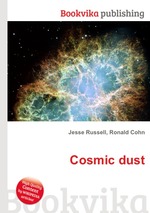Cosmic dust
Jesse Russell Ronald Cohn
бумажная книга
High Quality Content by WIKIPEDIA articles! Cosmic dust can be taken to be all dust in the cosmos, as its name implies, or limited to space dust in our solar system, as scientists who study dust in the solar system prefer. It is for the most part a type of small dust particles which are a few molecules to 0.1 µm in size. A smaller fraction of all dust in space consists of larger refractory minerals that condensed as matter left the stars. It is called "stardust" and is included in a separate section below. Cosmic dust can be further distinguished by its astronomical location: intergalactic dust, interstellar dust, interplanetary dust (such as in the zodiacal cloud) and circumplanetary dust (such as in a planetary ring). In our own Solar System, interplanetary dust causes the zodiacal light. Sources of solar system dust include comet dust, asteroidal dust, dust from the Kuiper belt, and interstellar dust passing through our solar system. The terminology has no specific application for describing materials found on the planet Earth except for dust that has demonstrably fallen to earth. In October 2011, scientists reported that cosmic dust contains complex organic matter ("amorphous organic solids with a mixed aromatic-aliphatic structure") that could be created naturally, and rapidly, by stars.


